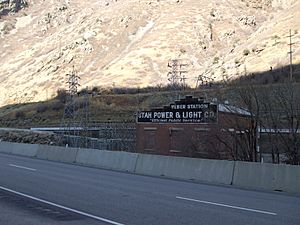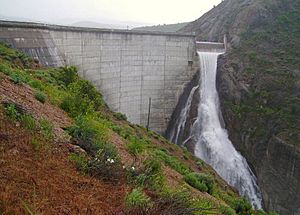Davis–Weber Canal facts for kids
The Davis–Weber Canal is a super important waterway in northern Utah. It's a long channel that helps bring water from the Weber River to homes and farms in parts of Weber and Davis counties. It even flows around the famous Hill Air Force Base!
What the Canal Does
This canal carries water for many different uses. People use it to water their gardens and lawns at home. Farmers also rely on it to water their crops. The water for the canal is stored in big reservoirs like the East Canyon Reservoir and the Echo Reservoir.
A special group called the Davis and Weber Counties Canal Company (DWCCC) owns and runs the canal. This company is a nonprofit organization that started way back in 1884! Their main office is in Sunset.

The canal starts on the south side of the Weber River. It begins right below the Devil's Gate-Weber Hydroelectric Power Plant in Weber Canyon. From there, the canal flows west. Sometimes it's an open channel, and sometimes it goes into underground pipes.
It travels through several cities. First, it goes through South Weber. Then, it crosses into Riverdale, flowing near the northern tip of Hill Air Force Base. After Riverdale, it briefly enters Roy.
Next, the canal enters Sunset. Here, it becomes an open canal again for a while. It continues south, sometimes going under roads and highways. It then enters Clearfield. In Clearfield, parts of the canal are open, and a walking path called the Clearfield Canal Trail runs alongside it. This trail is a great place for people to walk and enjoy the outdoors.
The canal then leaves Clearfield and enters Layton. In Layton, it mostly flows underground through neighborhoods. It passes by places like Northridge High School. Eventually, any extra water from the canal flows into Kays Creek. This creek then flows into the Farmington Bay of the Great Salt Lake.
How the Canal Started
The Davis–Weber Canal was first built in the mid-1880s. It was created by the DWCCC to help farmers get water for their crops. The original canal stretched about 23 miles (37 km) south to Fruit Heights.
To make sure there was always enough water, the DWCCC built a dam on East Canyon Creek. This creek flows into the Weber River. Over the years, the canal was improved. In the early 1910s, the original dirt canal was rebuilt and lined with concrete. This made it stronger and helped prevent water from leaking out.
The dam in East Canyon was also improved many times. The original dam was replaced with a new concrete one in the mid-1910s. Later, in the mid-1960s, a third dam was built by the United States Bureau of Reclamation. Even though the government built this last dam, the DWCCC still helps operate it.
Over time, many farms in the area became neighborhoods with houses. Because of this, starting in the 1980s, the canal began providing "secondary water." This is untreated water used only for watering lawns and gardens, not for drinking. By 2004, the canal was supplying this water to parts of Layton and Kaysville, as well as to the cities of Clinton and West Point.


